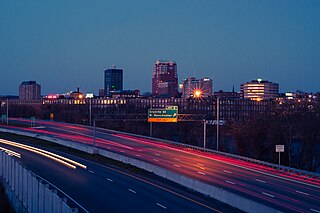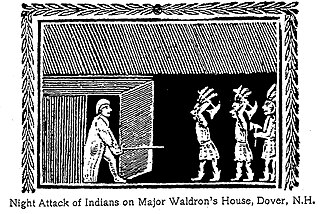
Hillsborough County is the most populous county in the U.S. state of New Hampshire. As of the 2020 census, the population was 422,937, almost one-third the population of the entire state. Its county seats are Manchester and Nashua, the state's two biggest cities. Hillsborough is northern New England's most populous county as well as its most densely populated.

Goffstown is a town in Hillsborough County, New Hampshire, United States. The population was 18,577 at the 2020 census. The compact center of town, where 3,366 people resided at the 2020 census, is defined by the U.S. Census Bureau as the Goffstown census-designated place and is located at the junctions of New Hampshire routes 114 and 13. Goffstown also includes the villages of Grasmere and Pinardville. The town is home to Saint Anselm College, the Goffstown Giant Pumpkin Regatta, and was the location of the New Hampshire State Prison for Women, prior to the prison's relocation to Concord in 2018.

Fremont is a town in Rockingham County, New Hampshire, United States. The population was 4,739 at the 2020 census, up from 4,283 at the 2010 census. Fremont is crossed by the Rockingham Recreation Trail and NH Route 107.

Hampton Falls is a town in Rockingham County, New Hampshire, United States. The population was 2,403 at the 2020 census.

Raymond is a town in Rockingham County, New Hampshire, United States. The population was 10,684 at the 2020 census. Part of Pawtuckaway State Park is in the north.

Pinus strobus, commonly called the eastern white pine, northern white pine, white pine, Weymouth pine (British), and soft pine is a large pine native to eastern North America. It occurs from Newfoundland, Canada, west through the Great Lakes region to southeastern Manitoba and Minnesota, United States, and south along the Appalachian Mountains and upper Piedmont to northernmost Georgia and perhaps very rarely in some of the higher elevations in northeastern Alabama. It is considered rare in Indiana.
Meshech Weare was an American farmer, lawyer, and revolutionary statesman from Seabrook and Hampton Falls, New Hampshire. He served as the first president of New Hampshire. Before 1784 the position of governor was referred to as “president of New Hampshire.” He is also called “The father of New Hampshire.” The first president of the earlier Province of New Hampshire was John Cutt.

A broad arrow, of which a pheon is a variant, is a stylised representation of a metal arrowhead, comprising a tang and two barbs meeting at a point. It is a symbol used traditionally in heraldry, most notably in England, and later by the British government to mark government property. It became particularly associated with the Board of Ordnance, and later the War Department and the Ministry of Defence. It was exported to other parts of the British Empire, where it was used in similar official contexts.

New Hampshire Route 114 is a 60.433-mile-long (97.257 km) secondary north–south highway in central New Hampshire. The highway runs between Bedford in Hillsborough County and Grantham in Sullivan County.
Abraham Drake was an officer in the New Hampshire militia that served with the Continental Army during the American Revolutionary War.

The Tree Flag was one of the flags used during the American Revolution. The flag, which featured a pine tree with the motto "An Appeal to Heaven," or less frequently "An Appeal to God", was originally used by a squadron of six frigates that were commissioned under George Washington's authority as Commander-in-chief of the Continental Army in October 1775.

Major Richard Waldron was an English-born merchant, soldier, and government official who rose to prominence in early colonial Dover, New Hampshire. His presence spread to greater New Hampshire and neighboring Massachusetts. He was the second president of the colonial New Hampshire Royal Council after it was first separated from Massachusetts.
David Dunbar was a British military officer, a surveyor of the King's woods in North America, and lieutenant governor of the Province of New Hampshire. Of Scotch-Irish origin, Dunbar married into a wealthy and politically influential family, and received his first North American appointment, that of Surveyor of the King's Woods, in 1728, through the influence of his family connections and that of Martin Bladen, a member of the Board of Trade. In this position he made numerous local enemies in his enforcement of regulations governing the cutting of trees that could be used as ship masts. He was the leader of an attempt to establish a colony named "Georgia" in what is now the central coast of Maine, and was in 1730 commissioned as lieutenant governor of the Province of New Hampshire in an attempt to strengthen his authority. He engaged in frequent disputes with New Hampshire's Governor Jonathan Belcher. He established Fort Frederick in Maine. In 1734, in an attempt to enforce the Broad Arrow policy of the Massachusetts Charter governing the protection of white pine trees of diameter greater than 24 inches for use in the making of ship masts, Dunbar and a group of his enforcers were run out of Exeter, New Hampshire. Dunbar had been interrogating townspeople about a large supply of white pine logs floating in a mill pond and about the ownership of the nearest timber mill.

Carla Gericke is an author, activist, and attorney. Born in South Africa, she immigrated to the United States in the 1990s after winning a green card in the Diversity Visa Lottery. She became a U.S. citizen in 2000. Gericke practiced law in South Africa, and California, working at Apple Computer, Borland, Logitech, and Scient Corporation. Gericke is President Emeritus of the Free State Project. In 2014, she won a landmark First Circuit Court of Appeals case that affirmed the First Amendment right to film police officers. That same year, she was named one of New Hampshire Magazine's "2014 Remarkable Women" In 2016, Gericke ran as a Republican for New Hampshire State Senate in District 20 against Democrat Lou D'Allesandro, garnering 40% of the vote in the general election. In 2018, after a successful recount on a write-in campaign on the Libertarian Party's ballot, she ran as a fusion Republican/Libertarian candidate and received 42% of the vote, up two percentage points in a year when District 20 swung 12–15% left due to the "Blue Wave." In 2020, Gericke ran again against D'Allesandro in District 20 and again lost, this time by a vote tally of 13,548 to 10,479, or approximately 56–44%.

Samuel Blodgett was an early American lawyer, industrialist, and financier who founded the city of Manchester, New Hampshire.













